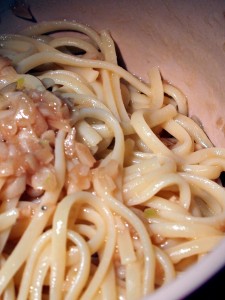 The An family runs a group of Vietnamese restaurants in California. The restaurants have different menus, but the family’s famous garlic noodles are on offer at each of them. I ate a dish of them at AnQi, the group’s newest restaurant in Costa Mesa – a restaurant so swanky it has a catwalk for fashion shows slashing a line through the tables – and discovered that those noodles are justly famous. (I can also heartily recommend the filet mignon potstickers, the shaken beef and the salt and pepper calamari.)
The An family runs a group of Vietnamese restaurants in California. The restaurants have different menus, but the family’s famous garlic noodles are on offer at each of them. I ate a dish of them at AnQi, the group’s newest restaurant in Costa Mesa – a restaurant so swanky it has a catwalk for fashion shows slashing a line through the tables – and discovered that those noodles are justly famous. (I can also heartily recommend the filet mignon potstickers, the shaken beef and the salt and pepper calamari.)
Those noodles though: stupendous. The An family has cottoned on to this, keeps the recipe secret, and tried to trademark the term “garlic noodles” a few years ago. Unsurprisingly, this was unsuccessful, but since then they’ve tried again with “An’s Famous Garlic Noodles”. So I should make the point here that the noodle recipe on this page is not the An family’s jealously guarded secret recipe, but my own (pretty successful) attempt at reverse-engineering the noodles I ate. They’re garlic dynamite, the sort of thing that you should consider eating to repel an unwanted suitor. The garlic is sweet, the buttery sauce gorgeously umami, and the whole arrangement coats the strands of wheat noodle (angel hair pasta is indistinguishable from what the restaurant uses) in a velvet-slick coating of flavour.
The Vietnamese have been working with what we’d now call fusion food for a couple of hundred years, the result of French colonialism. Some of the best Vietnamese food out there is a real mish-mash of cultures; just look at banh mi on rice-flour baguettes, with goose-liver pate spread thickly beneath the Vietnamese roast pork and pickled vegetables. So the use of butter and Parmesan cheese isn’t as barking here as it might look at first glance. This is a very easy recipe, but beware: this dish won’t just make your breath smell of garlic. Your hair, your sweat and the whole of your immediate environment will be curiously pungent for a good day or so after eating. Go with it. It’s worth it.
To make enough noodles to serve four as a side dish, you’ll need:
2 heads garlic
150g salted butter
1 tablespoon oyster sauce
2 heaped tablespoons grated Parmesan cheese
250g angel-hair pasta
Peel the garlic and use a large, sharp knife to chop it into very small pieces. If you hold the tip end of the knife in one hand and the bottom of the cutting blade in the other, you’ll find you can walk the knife up and down your board, chopping as it goes. Melt the butter and, over a very low heat, simmer the chopped garlic in it for about 20 minutes, until the garlic is soft and giving its fragrance up, but not browning. Stir the oyster sauce into the garlic and butter, and remove the pan from the heat.
Cook the pasta according to the timing on the packet, but using just enough water to cover the noodles. Drain, reserving the cooking liquid, and place in a serving bowl. Stir 50ml of the starchy water into the noodles along with the buttery garlic sauce and the Parmesan. Serve immediately.



